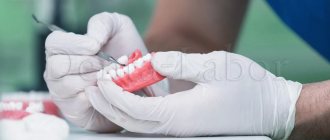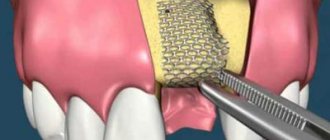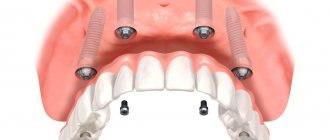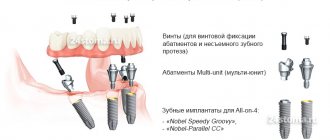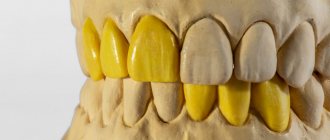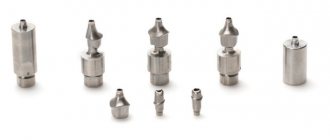The standard idea of prosthetics, as a rule, only covers the installation of an artificial crown that replaces an extracted or fallen tooth and restores the integrity and aesthetics of the row. In the case of implantation, a rod is also added to the number of required elements, replacing the root part and implanted into the structure of the bone tissue. However, few people know that in some dental restorations, one more component can be used – artificial gum, which replaces the missing area of the alveolar ridge.
Functions of artificial gum in implant-supported dentures
In removable dentures, artificial gum is a mandatory element. When the structures are simply fixed on the gums, the artificial gum provides additional fixation because it tightly grips the alveolar ridge.
In the case when the prosthesis is installed on implants, fastening elements are located inside it, just under the gum, on the back side of the dental crowns. Therefore, artificial gum helps to hide them, allowing you to give the dentition a sick aesthetic.
In some cases, doctors insist on adding artificial gum even to permanent dentures . Naturally, this surprises patients. But the gums also play a role, especially with extensive tooth loss or complete edentia. Dental crowns are used to fill the dentition, but artificial gums are used to fill the height of the bite.
This option is applicable for situations where, as a result of a long absence of teeth, your bone tissue has noticeably decreased in volume - the level of the gums, naturally, has fallen. And in order for the dentition to be even, you will have to either build up the bone to the required volume, or choose basal implants that are fixed in the existing bone volume, but then the prosthesis will have a small part of the gum. In addition, if the cause of tooth loss is diseases such as periodontitis or periodontitis, in which the tissues atrophy unevenly, with prosthetics without artificial gums it would be necessary to make crowns that differ significantly in height, which would be completely unsatisfactory from an aesthetic point of view. If bone atrophy is not significant, then the prosthesis is made without artificial gum.
Types of prostheses
One of the classification criteria used in dentistry is the range of design features of replacement products. Common orthopedic systems include:
- Models of the removable type with a pre-installed removable gum are divided into full structures, the fixation of which is ensured by the “suction cup” effect, as well as partially full ones – using clasps fixed on supporting elements. They include a hard coronal part, as well as a soft base that imitates gum tissue.
- Permanent dentures without artificial gums - as a rule, this group includes either bridge structures or implants. Unlike clasp models, integrated pins do not require preparation of the enamel of the supporting units, are implanted in any part of the row, and are resistant to increased loads arising during mechanical processing of food.
- Permanent models with artificial gums involve the use of zirconium dioxide ceramic materials, while the process of manufacturing and fixing crowns does not differ from the standard protocol, and depends, first of all, on the wishes of the patient and medical recommendations.
Classical implantation with bone tissue augmentation
To install implants of a standard classic type, a sufficient amount of bone tissue is required. In this case, you receive a denture without artificial gums, consisting solely of dental crowns. But you will lose in the following:
- the cost of treatment will increase: since the augmentation operation costs some money, besides, classical implantation is almost twice as expensive as the basal method,
- the treatment period will increase: at least three months are needed to restore the bone after augmentation and the same amount more for the complete engraftment of the implants, only after this it will be possible to install a permanent prosthesis
General overview
To make the shade of the prosthesis more identical to natural organs, the doctor strives to achieve maximum naturalness of the soft mucous membrane. For this purpose, artificial gum is used, which, in addition to the main support, adds aesthetics to the structure. The device makes the jaw row beautiful even with significant absence of teeth.
Their belated restoration causes atrophy of soft tissues and hard spongy areas of the gums in empty spaces. Under these circumstances, artificial gum ideally replaces the procedure of bone tissue augmentation. In addition, this method is more gentle and does not lead to unnecessary waste of money.
Expert opinion
Roman Borisovich Alekperov
orthopedic dentist
Experience: 24 years
Although artificial gum helps distribute the load on the jawbone, this distribution is not uniform. This means that over time, atrophic dentures will inevitably develop under the removable denture, the bone will sag, the denture will become uncomfortable, no longer fit, or may even break during chewing. How to prevent the development of bone deficiency? Only with the help of implantation! If you decide to install implants after the tissue has begun to “go away,” take advantage of the possibilities of basal implantation.
Plastic crowns
What is a plastic crown
In the modern world, life moves very quickly, and sometimes a person simply does not have time to go to the dentist.
Typically, this specialist is approached with advanced caries or severe pain. But dental problems cannot always be corrected with a filling. If the apex of the tooth is severely damaged (more than 50%), a crown is installed on it, which can be made of various materials - ceramics (porcelain), zirconium, metal and, in fact, plastic. So, what is a plastic tooth crown? These structures are created from medical plastic with the addition of acrylic resins. They are easy to make and also very cheap. It would seem like an ideal option. But despite the apparent attractiveness of plastic, its use in dental prosthetics is justified in isolated cases. Why? Read on.
Indications for installation of plastic prostheses
When are plastic structures used on teeth? In general, the purpose of such products is only temporary, and no self-respecting dentist will install them for a long time (except for removable prosthetics - we’ll look at that later in the article). Let's understand the indications for installing plastic crowns.
- to protect the prepared tooth from infection from the outside, that is, for the period while a permanent structure is being created,
- for single implantation: the top of the tooth is made of plastic while the artificial root takes root. It is necessary for the normal rehabilitation of the patient. This is also a temporary prosthetic option,
- with complete implantation: in the absence of a large number (or all teeth), a removable or conditionally removable plastic prosthesis is installed on the implants,
- with complete edentia: elderly patients often choose plastic orthopedic structures because of their attractive price,
- as a cost-effective alternative for urgent restoration of smile aesthetics.
Types of plastic crowns according to manufacturing method
- from pressed plastic: created by an orthopedic dentist from cold polymerized plastics. Installed only on incisors and canines, because cannot withstand heavy chewing loads,
- casting: created by a specialist in a dental laboratory within a few days. More durable, therefore can be used as a temporary prosthesis for chewing teeth during implantation with delayed loading,
- metal-plastic: in them the bottom layer is cast from metal, and the top is lined with plastic. This type has increased strength. If necessary, chips in the plastic layer can be quickly restored.
Types of crowns by time of use
Based on the time of use, plastic dental crowns are divided into temporary and permanent. But permanent ones are established not for many years - but for several months. They are suitable as a temporary option (while a permanent prosthesis is being made or until the chewing surface of artificial teeth becomes unusable). Let's take a closer look at each type.
Temporary plastic crowns
A temporary prosthesis is worn from several days to 3-4 weeks while the permanent one is being manufactured. Temporary ones are more porous and lighter than permanent ones, i.e. they require especially careful care (we will return to this topic later). They are necessary in the following cases:
- restoration of normal functioning of the chewing unit,
- restoration of smile aesthetics,
- prevention of injury and overheating of dentin during eating.
Permanent plastic dentures
Permanent (but, again, conditionally) plastic products are worn in the following cases:
- crown for one tooth: worn for no more than six months after implantation using the classical method. During this period, the artificial root completely fuses with the bone and permanent prosthetics can be made from a more durable material,
- complete denture during implantation: used for methods with immediate loading (implantation “all on 4”, “all on 6” and similar), when it is necessary to reduce the pressure on the installed implants. Such a prosthesis is considered relatively temporary - it needs to be worn for no more than 3 years, it is designed to replace all teeth,
- complete removable dentures - all the crowns in them are made of plastic (they will be discussed below).
This is interesting! Small private or municipal clinics still practice the use of plastic on an ongoing basis. For example, sometimes they make this option: a bridge is made of metal, and the top is lined with plastic (sometimes only on one side, the front side). Remember: unless we are talking about removable dentures, plastic cannot be used as a permanent option for replacing teeth!
Plastic products can be used as training products before permanent prosthetics. The patient walks with them for several days, and during the next visit to the orthopedist he talks about all the inconveniences of the bite. The product is adjusted until it no longer causes discomfort. And when making a permanent prosthesis, all identified nuances are taken into account.
Types of dentures that use plastic crowns
Orthopedic structures are removable (the patient can remove them himself) and non-removable (they can only be removed by the dentist).
Single dental crowns
They serve precisely as a temporary option to restore the shape and aesthetics of one tooth. They can be fixed both on the tissues of a living tooth and on an implant.
Removable structures
Removable full and partial dentures replace a large number of lost teeth (or completely edentulous teeth). Such structures consist of artificial gums (made of nylon, acrylic, polyurethane and other materials), as well as direct plastic crowns. In removable dentures, the teeth themselves are created from precisely this material. If you choose ceramics or zirconium, the cost of the structure will increase significantly (and removable devices are considered the cheapest).
In prostheses with complex implantation
If complex dental implantation is carried out, in which the implants must be immediately loaded with prostheses, plastics also come to the rescue. They are lightweight, do not overload the implants and allow them to fully take root. At the same time, aesthetics are restored and the ability to chew with new teeth is preserved.
Photos before and after
What do plastic crowns on the front teeth look like? Are they very different from the natural elements of the dentition? To find out exactly the answers to these questions, you can look at the photos before and after prosthetics - and everything will immediately become clear.
Advantages of plastic prostheses
What is so attractive about plastic crowns that patients often ask their dentist about them? Let's understand the advantages of plastic:
- lightness, possibility of quick and simple restoration,
- price: very low compared to analogues from other materials,
- ease of manufacture: in some cases, such a prosthesis can be made in literally 1 hour - and go home with a beautiful smile,
- good aesthetics at first.
Design disadvantages
Such designs require strong grinding of the teeth.
Along with a small number of advantages, plastic structures have an impressive baggage of disadvantages. Let us dwell in more detail on the disadvantages of such products:
- require strong grinding of the supporting element of the dentition,
- fragile and wear out quickly, which is why they differ from metal and ceramic ones,
- they quickly lose color from consuming any colored foods and drinks (even natural ones), as well as from tobacco - this is why the plastic crown darkens and it is impossible to whiten it normally,
- accumulate bacteria and unpleasant odors: microscopic food particles get stuck in the pores - they begin to decompose, which creates favorable conditions for the growth of microbes,
- toxic: acrylic plastics cause allergies and gum irritation,
- plastic breaks off from metal-plastic prostheses: destruction begins less than 1 year after installation,
- short service life: as a result of all the shortcomings, they are not suitable for long-term prosthetics.
Who should not have plastic on their teeth?
Bruxism wears down teeth
Despite the fact that plastic structures are quite convenient and simple, they have a number of contraindications for installation:
- Bruxism: a neurological problem characterized by uncontrollable teeth grinding. Strong squeezing of the jaws may cause the plastic to break, crack or split, causing injury to the mucous membrane or accidental ingestion of a foreign body,
- deep bite,
- cannot be used in children's prosthetics: the properties of the plastic can affect the correctness of the developing bite,
- allergy to components: the patient may not know about it until the prosthesis is placed. If irritation occurs, you should contact your dentist.
Stages of manufacturing structures
Plastic crowns can be made in two ways. Each of them has its own advantages and disadvantages. And each of the methods serves a specific purpose - to create an artificial crown for temporary or permanent wear.
In the dental office
Manufacturing at an appointment with an orthopedic dentist consists of the following steps:
- taking an impression of a tooth before preparing it: a dental impression mixture and a special tray are used,
- tooth preparation: turning is necessary so that the artificial structure does not stand out from the row and is fixed qualitatively,
- plastic is placed in the initial impression, the impression is placed on the tooth,
- After a short time, the mass hardens, the impression is carefully removed, and a plastic blank remains on the tooth. The orthopedist removes it, sharpens it and adjusts it in the right places,
- final fixation in the oral cavity.
Laboratory methods
This is what the process of making a crown in the laboratory looks like
In the denture laboratory, the fabrication of the structure begins after receiving an impression of the prepared unit. Includes the following steps:
- making a durable plaster cast,
- casting a wax model and adjusting it to the bite,
- evaporation of wax from a plaster cast,
- a plastic composite is placed into the impression and a blank is formed,
- the workpiece is boiled at a temperature of about 100⁰С, then cooled and polished,
- The product is given for fitting and fixed to the tooth after it has been adjusted to suit the bite.
The laboratory version takes more time to manufacture, so crowns are created in this way, which are used in classic removable or implant-fixed dentures.
How to install the structure
Installation and fixation is carried out using dental cement. How to place a plastic product? The orthopedist applies the required amount of fixing material, puts the crown on the tooth and presses it. It is generally not recommended to drink liquids within 2 hours or eat food within 4 hours after installation.
Of course, before installation, the supporting element must be treated for caries or pulpitis (if any). You also first need to carry out professional cleaning of all dentition - to remove microbial components, bacterial plaque and tartar.
How to remove a crown
It will not be possible to remove the structure yourself if it is securely fixed. To do this, you need to go to an orthopedist. What will the doctor do? Due to the nature of the material, sawing can be avoided. Ultrasound is applied here - it crushes the cement. Then a Kopp pneumatic apparatus is used, it pulls the structure out of its place. All manipulations are absolutely painless.
ROOTT implantation with immediate loading WITHOUT bone tissue augmentation
During ROOTT express implantation, specially designed implants are used, which eliminate the need for bone augmentation. They are fixed in the deepest layer of bone tissue (basal section), which is not subject to atrophy even after several years of missing teeth. As a result, the implants are securely attached and can withstand maximum loads for many decades. But you get a denture with a small piece of artificial gum. But you save in the following:
- the treatment period is reduced: the implants have a solid structure (the tip after installation remains above the gum level) and excellent primary stability, so immediate loading is allowed already 2-3 days after surgery. And due to the usual pressure, bone cells grow as quickly as possible around the installed implant.
- the cost of treatment is reduced: since augmentation surgery is not required, the number of treatment stages is reduced. Due to the reduction in treatment time, the cost is also reduced - when restoring completely lost teeth in two jaws, it is almost two times lower than the classical protocol,
Let us note that today artificial gums are made from modern materials and are matched in shade to the color of natural gums. As a result, the prosthesis is very thin, does not cause discomfort and is completely invisible to others.
How we restore teeth
OneDent dentistry installs a metal-ceramic crown with a turnkey inlay; the price includes all materials and labor.
- Stage I. The dentist performs antibacterial treatment of the root canals to eliminate the risk of infection. Then the canal is widened to accommodate the tab and one third of it is filled.
- Stage II. To make an inlay, the doctor takes impressions of the tooth and the unfilled part of the root canal, obtaining an exact copy of them.
- Stage III. The casts are sent to the laboratory, where a stump inlay is cast from a metal alloy.
- Stage IV. Next, the patient is invited to try on the inlay. The doctor makes adjustments and firmly fixes the structure in the dental canal using dental cement.
- Stage V. Now you need to manufacture and install a metal-ceramic crown on the inlay. To do this, the doctor once again takes an impression of the area of the dentition with the inlay already installed. Based on this impression, a crown will be made in the laboratory.
- Stage VI. All that remains is to install the crown and check the bite. The denture will be securely attached and only a dentist can remove it.
Healing time for gums around the abutment
You have to wear a screw with a wide head from several days to two to four weeks. The timing depends on how the healing and formation of the gingival contour proceeds. The characteristics and speed of these processes are influenced by the patient’s age, individual characteristics of the jaw, and careful adherence to the rules of dental hygiene. If inflammation occurs in the oral cavity, the former has to be worn longer. To reduce deadlines you need:
- follow all dentist recommendations;
- protect the oral cavity from infections;
- refrain from smoking;
- carefully monitor the condition of the tissues in the area of the installed implant.
In most cases, in the absence of complicating factors, after two weeks the dentist changes the forming screw to the abutment and fixes the permanent crown on it.
How to prepare for gingivoplasty?
You can make an appointment at our clinic in Moscow by phone number or using the feedback form on the website. First, you need to come for a consultation with a dentist, who will assess the amount of work, offer a treatment option and preliminarily determine the price for gum surgery when the tooth root is exposed, for example. Or he will tell you everything that is necessary to solve your clinical situation.
Before the operation, perform:
- treatment of carious cavities;
- elimination of acute inflammatory processes.
After gingivoplasty (local or generalized), you will have a healthy, beautiful and naturally radiant smile.
The stitches are removed after 10-12 days.
After gum surgery
Gum grafting against “gummy” and “shark” smiles
The gingival contour depends on many factors. Genetics, certain medications, and certain diseases lead to soft tissue hypertrophy. There are too many of them, which is why the teeth appear small, the so-called “shark smile” appears. In this case, gingivectomy is used. It consists of excision of excess tissue, elimination of gum pockets or hood, which occurs, for example, during the eruption of “wisdom teeth”. After excision of excess, the desired soft tissue contour is formed.
Many patients also resort to gum grafting, especially on the front teeth, if they have a gummy smile. It is characterized by the exposure of more than two millimeters of the upper gum when a person smiles, which gives the face a “horse” appearance. In this case, with the help of gum plastic surgery, excess soft tissue is removed from the surface of the teeth, and the gum contour is given a beautiful shape.
What is gum grafting?
Gum grafting is performed in a dental office under local anesthesia. It uses both traditional scalpels and laser technologies. The doctor decides what is suitable in your particular case. Often, in order to get a general idea of the result of the procedure, before it begins, the dentist draws the contours of the future position of the gums on the teeth.
The operation is performed by a periodontist. Before deciding on a procedure, carefully select an aesthetic dentistry clinic and find out the competence of your doctor: ask him about his experience and qualifications. Always look into your dentist's continuing education and ask to see examples of work they have already done.
How is gum augmentation performed?
The method of performing the operation is chosen by the doctor. To do this, the specialist first evaluates parameters such as the width and thickness of the gums. To restore its volume, patient tissue taken from the area of the extracted tooth or a palatal flap can be used. Along with this, artificial materials are also used, which are considered a progressive means of restoring the soft tissues of the oral cavity. These are collagen matrices or membranes.
Stages of gum growth:
- Antiseptic treatment of the oral cavity. If necessary, the manipulation area is isolated.
- Carrying out infiltration or conduction type anesthesia. For this purpose, injections of painkillers are used.
- Gum plastic surgery. If surgery is performed before the root replacement is installed, tissue incisions are made. When two operations are performed simultaneously, there is no need for additional dissections of the gums.
- Stitching. The edges of the cut fabrics are connected and sutured.
The entire operation takes 40–60 minutes. If collagen membranes are used for extensions, the time for plastic surgery is reduced by approximately three times.
